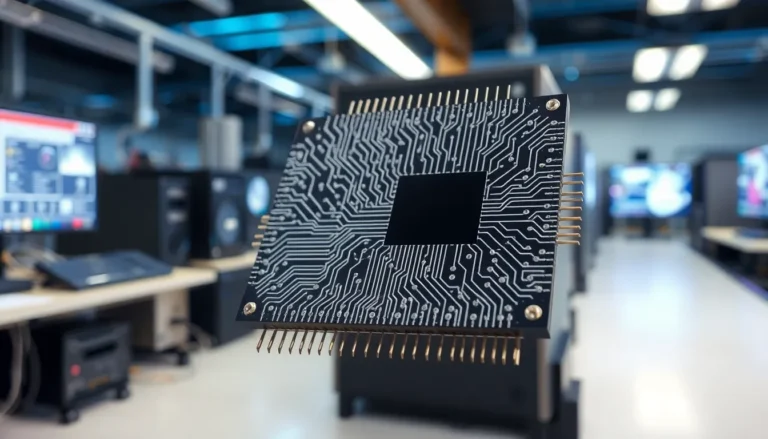In a world where speed is king and buffering is the enemy, the quest for 5G connectivity is on everyone’s lips—especially for iPhone users. Imagine streaming your favorite shows without a hitch or downloading apps faster than you can say “lightning cable.” It’s not just a dream; it’s a reality for many, but the question remains: can you really get 5G on your iPhone?
Table of Contents
ToggleOverview of 5G Technology
5G technology represents the fifth generation of mobile network advancements. This generation offers significantly improved speed, higher capacity, and lower latency compared to previous models. While 4G LTE provided adequate performance for many applications, 5G serves as a major upgrade, supporting advanced services like augmented reality and interconnected smart devices.
In terms of speed, 5G networks can deliver data rates exceeding 10 Gbps, enabling rapid downloads and seamless streaming. Users experience substantial improvements in video quality and online gaming. Latency, which refers to the delay in data transmission, drops to around 1 millisecond, allowing for real-time interaction in applications such as gaming and virtual reality.
5G operates on three frequency bands: low-band, mid-band, and high-band, each serving different purposes. Low-band 5G offers widespread coverage but delivers slower speeds. Mid-band 5G balances speed and coverage, providing a faster connection in urban areas. High-band, often called mmWave, delivers the fastest speeds but has limited range and is more susceptible to obstructions.
Significant infrastructure development is crucial for 5G deployment. Mobile carriers are investing heavily in small cell technology and densifying networks, facilitating better coverage in urban environments. This evolution transforms how individuals and businesses interact with technology, paving the way for innovative applications.
Consumers look forward to enhanced experiences, especially users of the latest iPhone models. These devices are designed to take full advantage of 5G capabilities. As 5G networks expand, iPhone users can expect improved connectivity and performance, reshaping mobile usage patterns.
iPhone Models with 5G Support
Numerous iPhone models support 5G connectivity. Each model offers specific features designed for optimal performance on 5G networks.
Compatible iPhone Versions
The iPhone 12 series introduced 5G capability, marking a significant upgrade. Each model, including the iPhone 12, iPhone 12 mini, iPhone 12 Pro, and iPhone 12 Pro Max, supports 5G. The iPhone 13 lineup further enhanced this feature with the iPhone 13, iPhone 13 mini, iPhone 13 Pro, and iPhone 13 Pro Max all compatible. Additionally, the iPhone 14 series continues this trend, with the iPhone 14, iPhone 14 Plus, iPhone 14 Pro, and iPhone 14 Pro Max fully supporting 5G technology. Users can enjoy faster connections with these models.
Network Compatibility
5G networks operate on various bands, and iPhones utilize multiple frequency bands for optimal performance. Users can access low-band for broader coverage and high-band for super-fast speeds. T-Mobile and Verizon provide extensive low-band coverage, while AT&T partners with companies to enhance mid-band availability. Additionally, the sub-6GHz and mmWave technologies support different usage scenarios. The iPhone models mentioned are built to harness these network capabilities, ensuring improved connectivity and speed in different environments. Mobile carriers continuously expand their 5G networks, enhancing user experience on supported iPhones.
Benefits of 5G on iPhone
5G technology introduces significant advantages for iPhone users. Enhanced performance and faster speeds become key features to explore.
Faster Download Speeds
5G facilitates download speeds that can exceed 10 Gbps. Users experience rapid access to large files and streaming content. For instance, downloading a full-length movie takes mere seconds compared to several minutes on 4G. This improvement transforms how individuals consume media. Seamless streaming becomes a reality, ensuring users enjoy high-definition video without buffering. Additionally, the increased speed supports effective performance of cloud-based applications.
Improved Connectivity
5G enhances connectivity for iPhone users across various environments. Users benefit from higher capacity and lower latency during peak usage times. For example, crowd-heavy locations, like concerts or sporting events, experience fewer dropped connections. The expansion of 5G networks increases reliability, making mobile gaming and video conferencing smoother. Moreover, smart device interoperability improves, allowing for seamless integration within the smart home ecosystem. Overall, 5G technology revolutionizes the user experience on iPhones, driving innovation and convenience.
Limitations and Considerations
While 5G technology offers impressive capabilities, certain limitations and considerations affect iPhone users. Understanding these factors is essential for making informed decisions about connectivity.
Coverage Area
Coverage areas for 5G vary significantly across regions. Some urban areas experience extensive coverage, while rural locations may lack sufficient infrastructure. T-Mobile and Verizon focus on low-band coverage, providing broader reach, but speeds may not match high-band options. Mid-band frequencies cover more ground than high-band but typically offer less speed. Users accessing 5G should check local network availability and the specific frequencies supported by their iPhone models. This ensures optimal performance and connection reliability.
Battery Life Impact
Battery life becomes a key concern with 5G connectivity. Higher data demands may result in increased power usage during prolonged sessions. Streaming high-definition content or downloading large files can quickly drain an iPhone’s battery. Users may notice shorter battery longevity when consistently using 5G, particularly in areas with weak signal strength, which requires more power to maintain the connection. Managing expectations surrounding battery consumption is important for maximizing device performance while using 5G features.
5G technology is reshaping the mobile experience for iPhone users. With models like the iPhone 12 and newer supporting this advanced connectivity, users can enjoy lightning-fast download speeds and improved streaming capabilities. As 5G networks continue to expand, the potential for enhanced performance in crowded areas and during peak usage times becomes increasingly evident.
However, users should remain mindful of coverage limitations and battery life impacts. As they navigate this new landscape, understanding local network availability and managing device settings will be crucial for maximizing their 5G experience. Embracing 5G opens up a world of possibilities, making it an exciting time for iPhone users looking to elevate their mobile connectivity.




